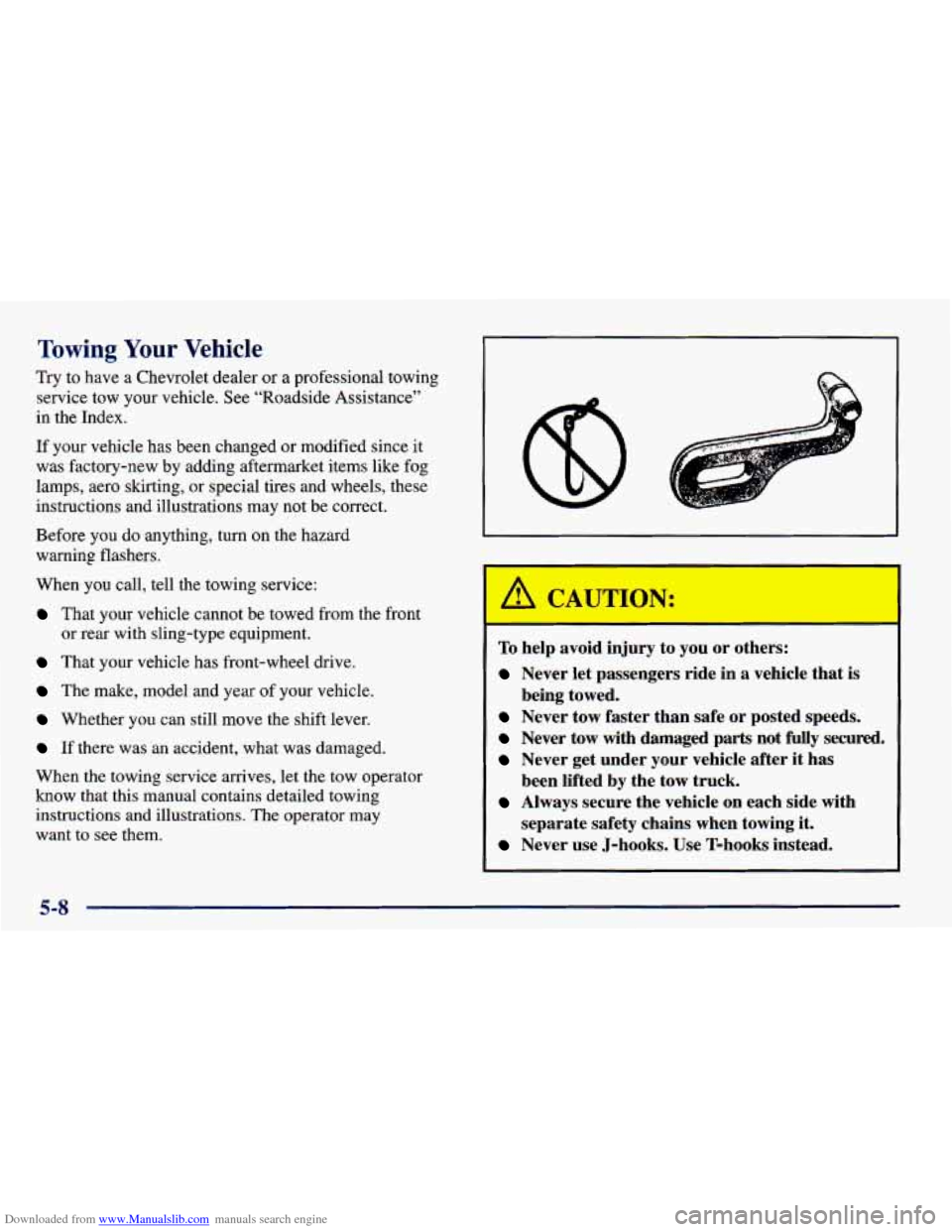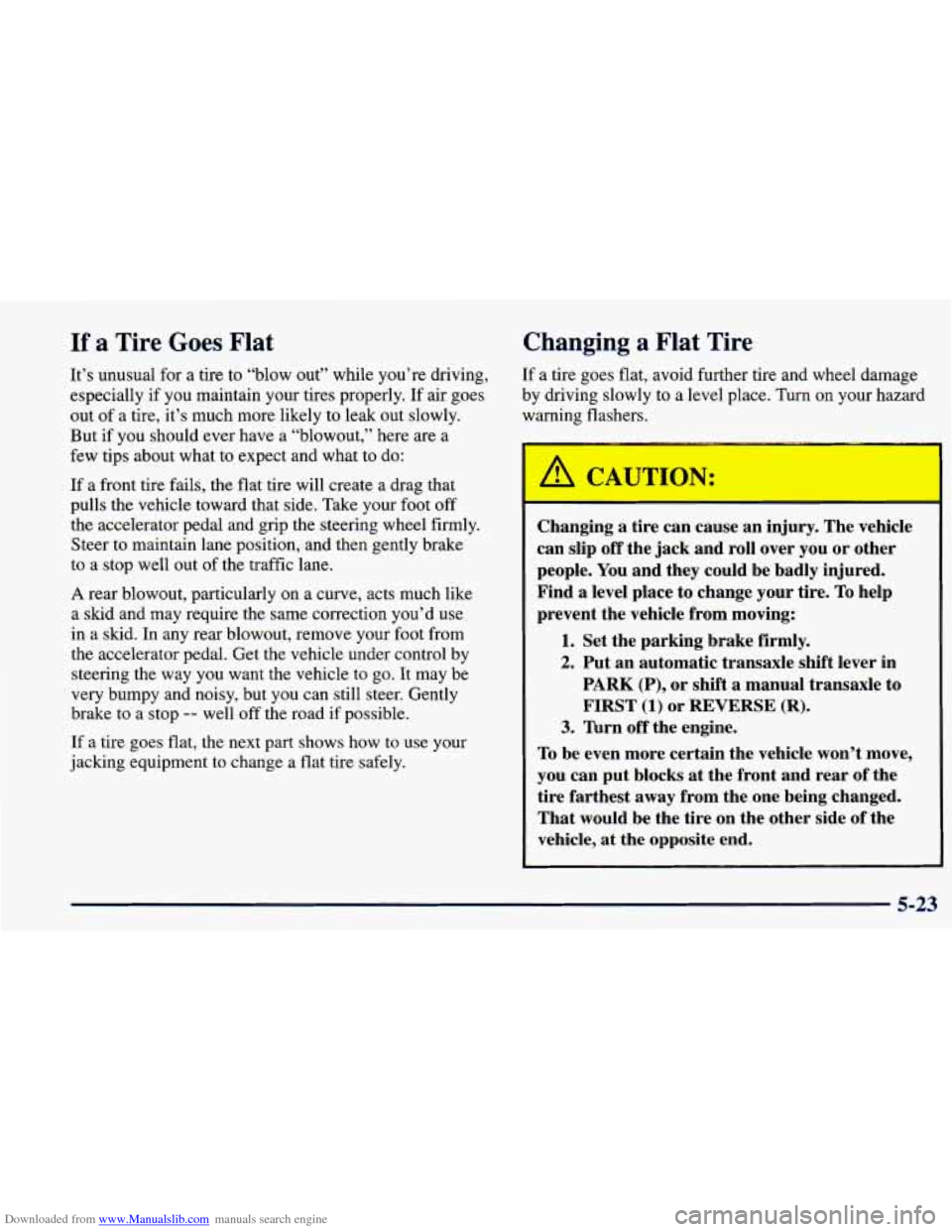Page 198 of 364

Downloaded from www.Manualslib.com manuals search engine Towing Your Vehicle
Try to have a Chevrolet dealer or a professional towing
service tow your vehicle. See “Roadside Assistance”
in the Index.
If your vehicle has been changed or modified since it
was factory-new by adding aftermarket items like fog
lamps, aero skirting, or special tires and wheels, these
instructions and illustrations may not be correct.
Before you do anything, turn on the hazard
warning flashers.
When you call, tell the towing service:
That your vehicle cannot be towed from the front
That your vehicle has front-wheel drive.
The make, model and year of your vehicle.
Whether you can still move the shift lever.
or
rear with sling-type equipment.
If there was an accident, what was damaged.
When the towing service arrives, let the tow operator
know that this manual contains detailed towing
instructions and illustrations. The operator may
want to see the
I
I
To help avoid injury to you or others:
Never let passengers ride in a vehicle that is
Never tow faster than safe or posted speeds.
Never tow with damaged parts not fully secured.
Never get under your vehicle after it has
been lifted by the tow truck.
Always secure the vehicle on each side with
separate safety chains when towing it.
Never use J-hooks. Use T-hooks instead.
being towed.
5-8
Page 199 of 364

Downloaded from www.Manualslib.com manuals search engine A vehicle can fall from a car carrier if it isn’t
adequately secured, This can cause a collision,
serious personal injury and vehicle damage. The
vehicle should be tightly secured with chains
or
steel cables before it is transported.
Don’t use substitutes (ropes, leather straps,
canvas webbing, etc.) that can be cut by sharp
edges underneath the towed vehicle. Always use
T-hooks inserted in the T-hook slots, Never use
J-hooks. They
will damage drivetrain and
suspension components.
When your vehicle is being towed, have the ignition
key turned to
OFF. The steering wheel should
be clamped in a straight-ahead position, with a
clamping device designed for towing service. Do not
use the vehicle’s steering column lock for this. The
transaxle should be in
NEUTRAL (N) and the
parking brake released.
Don’t have your vehicle towed with the front wheels in
contact with the ground if it has
an automatic transaxle.
If
a vehicle with an automatic transaxle must be towed
from the rear with wheel-lift equipment, the front
wheels must be supported on a dolly.
If your vehicle has a manual transaxle, don’t have it
towed on the front wheels unless you must. If a vehicle
with a manual transaxle must be towed on the front
wheels, it is recommended that the front wheels be
supported on a dolly. If you have a manual transaxle
and dollies won’t be used, turn the ignition key to
ACC
and put the transaxle in NEUTRAL (N).
5-9
Page 200 of 364
Downloaded from www.Manualslib.com manuals search engine Front Towing
NOTICE:
Do not tow with sling-type equipment or fascia
damage will occur.
Use wheel-lift or car-carrier equipment.
Additional ramping may be required for
carcarrier equipment. Use safety chains and
wheel straps.
Towing a vehicle over rough surfaces could
damage
a vehicle. Damage can occur from
vehicle to ground or vehicle to wheel-lift
equipment. To help avoid damage, raise the
vehicle until adequate clearance
is obtained
between the ground and/or wheel-lift equipment.
Do not attach winch cables or J-hooks to
suspension components when using car-carrier
equipment. Always use T-hooks inserted in the
T-hook slots.
5-10
Page 201 of 364
Downloaded from www.Manualslib.com manuals search engine Attach T-hook chains to the slots in the frame brackets,
just ahead
of the front wheels, on both sides. Attach a separate safety chain around the outboard
end
of each lower control arm.
Page 202 of 364
Downloaded from www.Manualslib.com manuals search engine Rear Towing
I
Attach T-hook chains to slots in the bottom of the floor
pan, just ahead of the rear wheels, on both sides.
1 NOTICE:
Do not tow with sling-type equipment or rear
bumper valance
will be damaged.
NOTICE: (Continued)
5-12
Page 203 of 364
Downloaded from www.Manualslib.com manuals search engine NOTICE: (Continued)
Use wheel-lift or carcarrier equipment.
Additional ramping may be required for
carcarrier equipment.
Use safety chains and wheel straps.
Dollies are required under the front
wheels or
damage will occur.
Attach a separate safety chain around the outboard end
of each lower control arm.
5-13
Page 213 of 364

Downloaded from www.Manualslib.com manuals search engine If a Tire Goes Flat
It’s unusual for a tire to “blow out” while you’re driving,
especially if you maintain your tires properly. If air goes
out
of a tire, it’s much more likely to leak out slowly.
But if you should ever have a “blowout,” here are a
few tips about what to expect and what to do:
If a front tire fails, the flat tire will create a drag that
pulls the vehicle toward that side. Take your foot off
the accelerator pedal and grip the steering wheel firmly.
Steer to maintain lane position, and then gently brake
to
a stop well out of the traffic lane.
A rear blowout, particularly on a curve, acts much like
a
skid and may require the same correction you’d use
in a skid. In any rear blowout, remove your foot from
the accelerator pedal. Get the vehicle under control by steering the way you want the vehicle to
go. It may be
very bumpy and noisy, but you can still steer. Gently
brake to a stop
-- well off the road if possible.
If a tire goes flat, the next part shows how to use your
jacking equipment to change a flat tire safely.
Changing a Flat Tire
If a tire goes flat, avoid further tire and wheel damage
by driving slowly to a level place. Turn on your hazard
warning flashers.
Changing a tire can cause an injury. The vehicle
can slip
off the jack and roll over you or other
people. You and they could be badly injured.
Find a level place to change your tire. To help
prevent the vehicle from moving:
1. Set the parking brake firmly.
2. Put an automatic transaxle shift lever in
PARK
(P), or shift a manual transaxle to
FIRST
(1) or REVERSE (R).
3. lbrn off the engine.
To be even more certain the vehicle won’t move,
you can put blocks at the front and rear of the
tire farthest away from the one being changed.
That would be the tire on the other side of the
vehicle, at the opposite end.
5-23
Page 214 of 364
Downloaded from www.Manualslib.com manuals search engine The following steps will tell you how to use the jack and
change a tire.
Removine the Spare Tire and Tools
A. Spare Tire
B . Jack Handle
C. Wheel Wrench
D. Jack
The equipment you’ll need is in the trunk.
Lift the spare tire cover to gain access to
the spare
tire
and tools. Remove the foam tray containing the
jacking tools.
Turn the knob to the left and remove it.
5-24